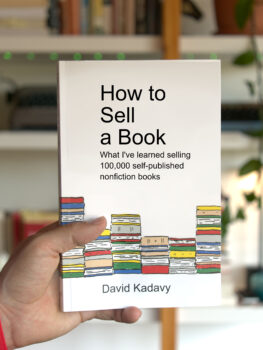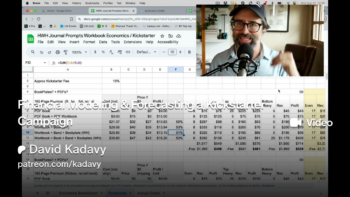Subscribe to blog updates via email »
August 2024 Income Report
To listen to an audio version of this report, join the Patreon »
August’s revenue was $9,077, down from July’s $9,084. Profits were $5,082, down from July’s $5,553.


WANT TO WRITE A BOOK?
Download your FREE copy of How to Write a Book »
(for a limited time)
Record direct-sales income
Record direct-sales income: $5,088 on books, thanks to $4,101 total from Kickstarter, which included some Misc. Products not counted in direct sales of books. This is nearly triple the previous record, when I made $1,780 in June 2020, from the Preview Edition of Mind Management.
This outlier month puts a huge lump in the portion of self-published books generated by direct sales. Direct sales were 66.6% of book sales, which brought my six-month average share from 16.7% to 29.8%. Recall that at the beginning of the year, I estimated 60% confidence I could grow that share to 10%, and 30% confidence I could grow it to 30%.
If I keep this up, my direct-sales graph can graduate out of the log. scale.

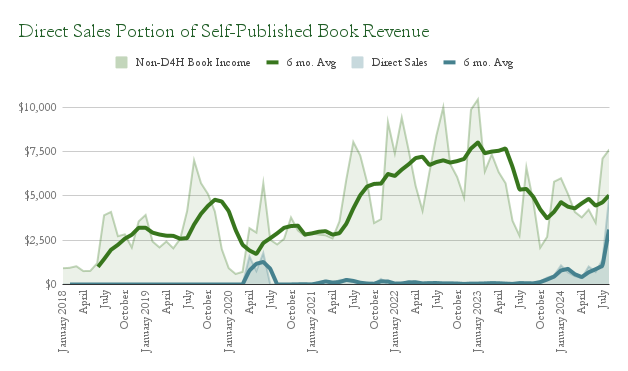
My direct sales, as compared to overall book sales, without the log. scale.
High expenses for direct sales
While direct-sales revenue was a record, my expenses for servicing that revenue were very high, too. Probably also a record. I spent $1,607 on “Book Printing,” for which my payments to BookVault are a proxy. In reality, much of that should go to “Shipping and Handling,” but I don’t have that level of detail in my reporting at this time.
I used BookVault to print and ship journal-prompt workbooks and HWH books to any Kickstarter backers who didn’t order packages that included wristbands and book plates. My “Shipping and Handling” bill is low this month, at $117, but it will be higher next month, as I get billed by my warehouse for sending to backers reward packages that included wristbands and book plates.
Journal Prompts Workbook Kickstarter mostly fulfilled
The Kickstarter for the 100 Journal Prompts Workbook made $4,101. After Kickstarter fees, I received a payment of $3,746, but since I don’t track payment processing fees in these reports, my numbers are based upon the former.
Two weeks after the end of the campaign, I received that payment, and so had the funding to order and ship workbooks and books. Nearly all backers have been sent their rewards, but there are some from whom I received address information late, or am still awaiting address information!
Assessing direct-sales revenue from Kickstarter packages
I had to use some accounting tricks on my Kickstarter earnings so they got divided appropriately amongst items included in rewards. The challenge was that items were grouped together in packages, so if someone paid $47 and got four items, each with distinct value, how to divide that up? Additionally, much of the revenue collected was for shipping charges, which were established as flat values such as $5 or $15, not perfectly representative of actual shipping costs.
To estimate how much revenue each item earned, I estimated the total values of each item fulfilled by multiplying the quantity times the estimated value of one such item. But the totals of such totals was close to $4,500. Yet the campaign only earned $4,101, which makes sense since items were bundled and so were discounted.
So I multiplied the percentage portion each item made of that total by the campaign’s total earnings, to get an estimated total revenue for each item.
Here is that breakdown
- HWH ebook: $679
- JPW ebook: $663
- JPW: $1,739
- HWH: $607
- Book plates: $147
- Wristbands: $265
- Total: $4,101
The most imperfect feature of this method is that there’s no “shipping revenue,” for the shipping charges. But, this is good enough.
Digital Products changing to Misc. Products
Last month I removed the Digital Products category, in a trial. This month, I’ve realized I have some anomalies in my revenue with the portion that comes from book plates and wristbands.
I considered creating a new category called “Physical Products,” but there would be a few problems with that: One, I’d have a new category to track in my “Revenue, by category” graph. Two, I’m not committed to expanding my line of physical products. Three, I’m not ruling out selling in the future more digital products.
Thus, I’ll change the category to Misc. Products, and data from the past that was called Digital Products, will be attributed to Misc. Products. So my graph remains intact.

Audiobook deals coming up!
After consistently applying for Chirp deals for a few months, MMT has finally been accepted for one! The last time I had a Chirp deal for MMT was July 2023. I went from selling 59 units through Findaway for $90 revenue, to selling 395 and 199 units for $251 and $197 in the two respective months during which the deal ran. My Audible sales went from 98 units for $221 revenue during the first month of that promotion, to 358 units for $901 revenue – which may or may not have been related.
All wide audiobooks will be discounted
To really put my wide audiobook potential to the test, I’ll be discounting all my audiobook titles across all retailers for which I can schedule deals through Findaway Voices, as complements to this Chirp deal.
The following pricing promotions are scheduled for October 12 through November 9, on Chirp, Spotify, Apple, and B&N:
- MMT: $14.99 to $1.99
- HTS: $7.95 to $3.49
- ZET: $5.99 to $2.99
- WAB: $4.95 to $1.99
Looking at those again, I kind of wish I had marked HTS down to $2.49, but you can’t edit these once they’re scheduled. According to Findaway, nor can you be guaranteed these promotions will actually run.
I’ve thought a little about whether I want to also run these price promotions on my direct audiobooks, or promote them to my email list. Still not sure. Audiobooks purchased directly from me are in some sense more valuable than those “rented” from retailers.
Promotions spreadsheet helping
This Chirp deal comes as I’ve been questioning the value of being wide with my audiobooks. I posted about it in the 20 Books to 50k Facebook Group. I wonder if a Chirp editor saw it and that has anything to do with MMT finally being selected. It was rejected in July and August.
Or, it’s simply helping that I’m finally applying for promotions consistently, thanks to the promotions Airtable base I’ve been iterating on.
I’ve written in the past about some of the challenges of making a spreadsheet that makes it clear at any given moment what promotions I’m eligible to apply for, which ones are pending, and which are active. But, I’ve got something that at least makes it much easier to figure these things out than trying to keep the information in my head, or in various disparate notes.
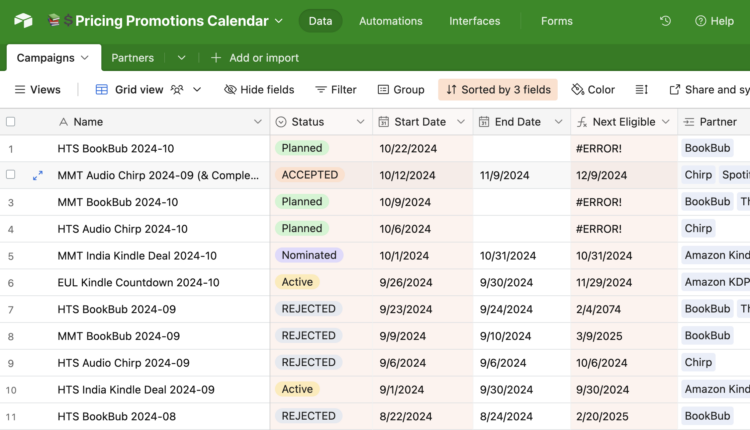
The spreadsheet I’ve been iterating on to keep track of pricing promotions.
This is especially helping me keep on top of Kindle Deals, which will be ruined if I change my price in the given deal’s region.
More edits on How to Sell a Book
I’ve just finished my third pass of edits on How to Sell a Book. This may be my final pass before I publish it. I’ve restructured it a little, punched up various sections with illustrations, worked to make the writing more concise, and of course fixed lots of typos. I have some final tweaks to make, then it’s time to make the index.
I’m not sure what to make of how little feedback I’ve gotten on the Preview Edition. There were almost no edits on the Google Doc, and I had a hard time getting survey responses. When I released the Preview Edition of MMT, I surveyed 198 people, and, promising to give away a $10 Amazon Gift Card, got 12 responses. For HSB, I surveyed 77 people, promised to give away a $15 Amazon Gift Card, and got 7 responses.
I hadn’t realized until I wrote that, that’s actually a higher response rate: 9%, vs. 6%. But, while MMT had the majority of ratings at 5, on a 1–5 scale, HSB had the majority of ratings at 4.
Out of all seven respondents, none of them had published a book before, which makes me wonder who the book is for. I’m sharing the most advanced stuff that it’s taken me years to learn. Will it be useful to first-time authors, or will it overwhelm them?
How to Sell a Book open for preorders
As I put the finishing touches on HSB, I’m taking preorders (outside U.S.). I considered doing another Kickstarter. That’s probably the way to make the most money, but this last one was a lot of work, and the other downsides were the two-week delay in getting paid, and having to chase down backers for address information.
So, I’m taking preorders on Shopify. This way, I could get the money immediately, have it available to print and ship books, and have address information from the beginning.
I’m taking preorders, offering a discount coupon (HSBPreOrder), then I’ll fulfill paperback orders manually through IngramSpark. Why? Here are my cost breakdowns from various POD services:
BookVault UK: $13.98 per book. The downside, besides the cost, is it would take 2–3 weeks to ship to customer.
BookVault US: $11.74 per book. This would cost less, but I’ve heard bad things about the quality of books printed by BookVault’s U.S. operation. No idea if those kinks have been worked out.
BookVault UK, from my warehouse: $13.82 per book. Can ship faster once books are in warehouse, but a point of pre-orders is to know how many books need to be shipped to warehouse, so it would end up taking even longer, at almost no savings.
Drop-ship from KDP Print: $8.88 per book. Way cheaper! Will ship with the price on the packing slip, but that’s okay for pre-orders. A downside is having to order manually. The major downside is I’d have to release the book on Amazon to order the books, and that’s not acceptable. I want my readers to get the book well before anyone can buy it on Amazon.
Drop-ship from IngramSpark: $9.05 per book. Still have to order manually, costs a bit more than through KDP Print, costs are still printed on packing slip, but I can control the publication date of the First Edition in places outside of my own store.
There’s not a feasible way to process orders by drop-shipping through IngramSpark on an ongoing basis, but if I’m processing all orders at once, it’s worth it to save nearly $4 per book. And I could pass on some of those savings to readers who pre-order.
These numbers would be for orders to customers in the U.S. I’d still need to figure out how best to handle orders to other countries. I’d probably just print and ship through BookVault UK. Calculating shipping costs can get hairy, but I may have figured out a way to make that automatic when purchasing through Shopify.
I’ve also considered a pre-order bonus such as a Q&A or group coaching call, but still not sure about that. I don’t want to overcomplicate finally getting this book published, so I can get on to the next thing!
Why a U.S. and International page?
I’m taking this opportunity to test an idea for handling an issue I’ve had with Shopify shipping profiles to handle orders both for the U.S., to which I fulfill orders through my warehouse, and other countries, to which I fulfill orders through BookVault.
The problem, basically, is that BookVault injects a shipping profile into Shopify. Each item can only be in one shipping profile at a time (without tricks from an app, at least). So currently I manually have created a shipping zone for my warehouse within the profile BookVault has injected. But that will inevitably break the next time the BookVault app updates the profile. It’s a ticking time-bomb.
The best solution, it seems is to have duplicates of each product, one will only display in the U.S., the other internationally, and each will be in the appropriate shipping profile.
So far, it’s certainly awkward to have to share two links. And either link will throw a 404 if you visit the wrong one.
Managing a Shopify store is so complicated! Sometimes I think I might be better off only selling direct to the U.S. until I get some kinks worked out.
Lots of visa stuff
One of the phantom costs of living in another country is dealing with immigration issues. Just when you think you’ve got everything buttoned up, some emergency arises that commands your time and energy.
Colombian Residency “transfer”
One of these emergencies arose several weeks ago, when I found out that my Colombian Resident visa, which displayed an expiration date in 2027, was soon going to expire. How can a visa with a 2027 expiration date expire? Apparently a law was passed that everyone with existing visas had to “transfer” their visa into the “new” system or set of rules or something.
When I first heard about this, I started having flashbacks to the visa issues I’ve had in the past, which I wrote about in MMT, which caused me to have to make several emergency trips out of the country.
Fortunately this turned out to be much easier and less fraught than my visa requests have been. Still, it was nearly a couple dozen hours of calling the Cancillería and Migración, driving down the the Migración office in Medellín, visiting the notary to give my wife power of attorney to run another errand to Migración, and uploading documents to the Cancillería website.
But, I did get my renewed visa, now with an expiration date in 2029. But I apparently need to keep a lookout for changes that, if they happen, I won’t be notified of.
Now that I have the renewed visa, I need to renew my government ID card, my cédula. I’m supposed to do this within two weeks of receiving the visa, but there are no appointments available. I waited at the ready to snag a new appointment when they opened up at 5 p.m. on Sunday, but they were all gone before I could grab one. I’ll have to be quicker this Sunday.
Wife’s U.S. tourist visa application (and rejection)
A much bigger project was applying for and preparing my wife for her interview for a tourist visa to the U.S. Most Americans are shocked to learn that citizens of various countries need to travel to their nearest U.S. Embassy to apply for a tourist visa to get permission to visit the United States.
Most Americans are even more shocked to learn that even spouses of American citizens abroad need to go through this process, and in fact that being married to an American expat appears to work against them. Consul officers are required to assume intent to abuse one’s travel privileges and immigrate to the U.S. If they don’t learn something in the interview to convince them the applicant won’t do so, they have to reject the applicant.
So, when an applicant is married to an American expat, that only adds to the suspicion that the applicant has a reason to stay once they’ve arrived in the U.S. Their spouse can stay, no problem, so they’ll likely do the same. Ironically, this means consul officers are advised (or required?) to distrust their own law-abiding citizens, assuming they would be privy to such a violation.
Even more ironically, foreign spouses of American expats are eligible to immigrate to the U.S. by applying for a Green Card, and their acceptance rate for those is quite high. But a Green Card requires spending six months out of the year living in the U.S. So rather than allow a foreigner to travel to the U.S. with their expat spouse, they’re highly encouraged, and in many cases little more than forced to pick up and move back to the United States merely so their spouse can visit their family and so they can show their spouse their birthplace.
I have one friend who did just that. After his wife was rejected for a tourist visa four times, they got her a Green Card, lived in the U.S. for two years while she got her citizenship, and, mission accomplished, will soon move back to Colombia. This friend, by the way, is a wounded veteran of the U.S. military with a titanium chest plate in his body.
People who know a little about U.S. immigration often suggest upon hearing this the “90-day Fiancé” visa they’ve seen on TV. But foreign spouses of American citizens abroad can’t get that visa, because they’re already married.
Foreign spouses of American expats who don’t want to immigrate find themselves in a Catch-22: They can’t get the tourist visa because they’re suspected of trying to immigrate, yet they can’t get the Green Card because they don’t want to immigrate. The whole thing doesn’t make logical sense, and probably is merely a highly-inconvenient externality of a system put together to achieve some other goal.
The only logical reason I could think of why the U.S. government would want this would be more tax revenue from the U.S. citizen. That’s a possibility, but more likely an accident.
To make this situation more frustrating, the Bureau of Consular Affairs is underfunded and understaffed. When we applied for a visa this time, the soonest appointment was eighteen months in the future. After checking regularly, we were able to find an earlier appointment, only one year after we applied. So there are long wait times for visa interviews, and consul officers have a tough job: They have approximately thirty seconds to three minutes to conduct each interview, otherwise they’ll be reprimanded by their bosses. In the four hours before lunch, they’re expected to conduct one-hundred interviews.
The result is that when applying for a tourist visa, you have to be highly-prepared to make the right impression in moments, to a consular officer who is behind glass, talking through a phone, and mostly not even looking at you. So you spend weeks putting together documents about your income, relationship, trip plans, and ties to your country, and likely the officer won’t look at any of it. But if they request any documentation, you better have it!
So the interview is key. You have a pretty good idea the main questions they’ll ask, but you have to strike a balance between giving a short answer that respects the officer’s time, and a slightly longer answer that conveys your qualifications for the visa. You never know whether the question you’re asked is going to be your last chance to speak.
So, over the past several weeks, I’ve spent dozens if not a hundred hours planning our case, putting together documentation, developing a plan for Ana’s interview, and helping her rehearse. (We’ve had lawyers do this for us in the past, but they never did it like they cared and it didn’t lead to positive outcomes. We learned to understand the process much better this time doing it ourselves, with some professional guidance.)
Then we flew to Bogotá, stayed in a hotel (the interview requires a separate appointment the day before), and I waited outside (only applicants are allowed in).
And her visa was rejected. This is the third time in ten years.
Here is Ana with the binder we prepared. We were requesting permission to visit my father, who is unable to travel, as he has a Severe Mental Illness designation by the State of Arizona and receives specialized care in an assisted living facility.
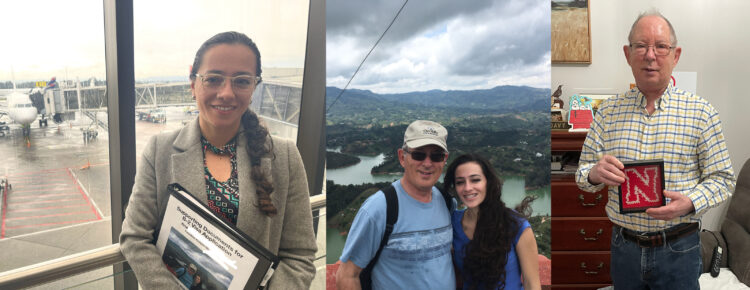
Ana with her interview packet, on the way to Bogotá, and with my dad in 2017. Dad with a gift Ana crocheted for him, 2022.
So, when I go to Arizona to celebrate Thanksgiving with family, I will once again go alone.
I don’t know what options we have next, as three rejections practically guarantees a fourth, fifth, etc., and our life is in Colombia.
Removing How to Write a Book Spanish version from reports
The point of these reports is to make me aware of information I can use to make decisions in my business. Reporting on WAB Spanish sales hasn’t served that purpose for a long time, as the income coming in is low, and I’ve learned my lesson that it’s not worth it to try to release your own foreign-language translations of your books.
So, I’m removing WAB Spanish sales from these reports. This should help me save a tiny bit of time and energy each month, which I can use toward something more productive.
New on Patreon: Financial modeling & forecasting a Kickstarter campaign
This month on Patreon, I’ve shared a bonus screencast showing how I modeled and forecast my recent Kickstarter campaign for the Journal Prompts Workbook.
I describe how I calculated costs, determined pricing, and forecasted for various outcomes.
I’ve been trying to add at least one new piece of bonus content per month over the past several months, just for Patreon supporters. Some other recent additions:
- Setting up a book on BookVault and ordering an ARC
- My carry on travel packing and gadgets
- How I compile book-sales reports as a “wide” self-published author
- How I use Todoist for GTD and Mind Management
- Evaluating foreign-rights opportunities as a self-published author
- Quarantining and Warming Up New Email Subscribers from Facebook Lead Ads
- A tour of my Shopify store & Meta ads
Join the Patreon to get instant access to all these, plus audio versions of these reports. (Join through the website, not the iOS app, to avoid higher fees.)
Income
Book Sales
| Mind Management, Not Time Management Kindle | $395 |
| Mind Management, Not Time Management Paperback (Amazon) | $823 |
| Mind Management, Not Time Management (non-Amazon) | $346 |
| Mind Management, Not Time Management Audiobook | $667 |
| 100-Word Writing Habit | $1,668 |
| Journal Prompts Workbook | $2,402 |
| Digital Zettelkasten Kindle | $633 |
| Digital Zettelkasten Wide (non-Kindle) | $346 |
| Digital Zettelkasten Audiobook | $84 |
| The Heart to Start Kindle | $129 |
| The Heart to Start Paperback (Amazon) | $57 |
| The Heart to Start “Wide” (non-Amazon) | $16 |
| The Heart to Start Audiobook | $16 |
| How to Write a Book Kindle | $18 |
| How to Write a Book Paperback | $11 |
| How to Write a Book “Wide” (non-Amazon) | $20 |
| How to Write a Book Audiobook | $4 |
| Total Book Sales | $7,635 |
Misc. Products
| 100-Word Habit Wristband | $265 |
| Signed Book Plates | $147 |
| Total Misc. Products | $412 |
Affiliates / Advertising
| Active Campaign | $635 |
| Alliance of Independent Authors | $234 |
| Amazon | $14 |
| Google AdSense | $0 |
| SendOwl | $5 |
| Total Affiliates | $888 |
Reader Support
| Patreon | $143 |
| Total Reader Support | $143 |
Services
| Clarity | $0 |
| Medium | $0 |
| Total Services | $0 |
| GROSS INCOME | $9,077 |
Expenses
General
| Accounting | $0 |
| Book Printing | $1,607 |
| Outside Contractors | $0 |
| Quickbooks | $27 |
| Shipping and Handling | $117 |
| Total General | $1,751 |
Advertising
| Amazon | $1,400 |
| BookBub | $0 |
| $8 | |
| Meta | $446 |
| Influencer Marketing | $0 |
| Product Samples | $0 |
| Total Advertising | $1,853 |
Hosting
| ActiveCampaign | $135 |
| Bookfunnel | $15 |
| Drafts | $2 |
| Dropbox | $10 |
| Fathom Analtyics | $14 |
| Libsyn | $5 |
| Namecheap | $31 |
| Obsidian Publish | $10 |
| SendOwl | $9 |
| Shopify | $39 |
| Ulysses | $3 |
| WP Engine | $96 |
| X (Twitter) | $8 |
| Zapier | $14 |
| Total Hosting | $391 |
| TOTAL EXPENSES | $3,995 |
| NET PROFIT | $5,082 |

